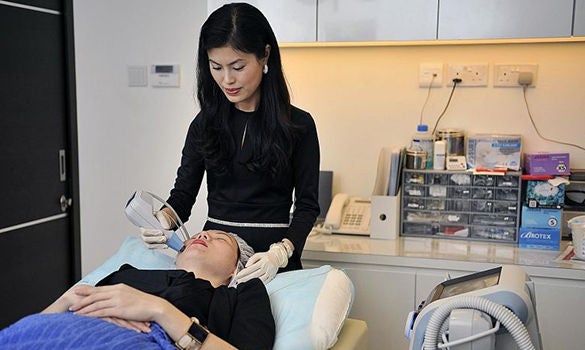
Laser resurfacing uses laser to remove the outermost layers of skin to improve appearance. PHOTO: ST FILE
It is common in Asian cultures to hear of elders advising those who have chickenpox to avoid consuming dark sauce in case their scars turn dark.
Another old wives' tale is to avoid eating seafood and eggs after surgery as these foods will cause ugly scarring.
"There is no medical evidence to prove these theories, but I usually tell my patients that if it is something they believe in, it's better to avoid (eating such things)," said Dr Pearlie Tan, a consultant at the department of plastic, reconstructive and aesthetic surgery at Singapore General Hospital.
This is because if they develop an unattractive scar, they would think it was due to the prawn or squid they ate, she added.
Scars are permanent, though many do fade and become less noticeable over time.
Some scars, such as keloids - raised scars that are more common in Asians than Caucasians - can grow much larger than the wound that caused the scar.
Treatments can make scars less visible. In general, the earlier a scar gets treated, the better the results, said Dr Tan.
Some scars can become dry, painful and intensely itchy. If a scar forms over a joint, it can become a tight band that restricts movement. Severe scars may need a combination of plastic surgery and adjuvant treatment such as laser therapy or corticosteroid injections.
SILICONE GEL AND SHEETS
These can improve the texture, colour and height of scars. They can also help in lessening the pain and itching some scars cause.
Dr Tan said silicone sheets keep scars hydrated and can be effective in reducing thickness, pain, itchiness and pliability of some thickened, raised scars.
Silicone sheets should be worn for as many hours of the day as possible - at least for 12 hours.
Silicone gel helps to hydrate scars and has been shown to be effective in softening them while reducing itching and discomfort.
Apply it twice a day, said Dr Tan, and if you plan to go out, apply sunblock on top of the silicone gel.
SCAR MASSAGE
After your incision has healed, your surgeon will show you how to perform scar massage using either moisturiser or silicone gel.
The massage and use of silicone gel help with overall scar therapy and maintenance, but will not make scars disappear.
LASER-RESURFACING TECHNIQUES
These use laser to remove the outermost layers of skin to improve appearance.
A combination of these, together with the use of natural or synthetic skin fillers, can be used to treat thinned-out or atrophic scars, for instance. These are scars that sit below the surface of the skin and can develop after severe acne or chicken pox.
Skin fillers may be done with our own fat (autologous fat grafting) or with synthetic (hyaluronic acid) material.
Autologous fat grafting has been shown to improve both the appearance and symptoms of scars, with the scars trending towards more normal-looking skin.
PLASTIC SURGERY
This may be needed depending on the severity of the scars. It can be done to improve appearance and reduce pain.
• Dr Tan's department will be holding a free public forum titled Unmasking Plastic Surgery at the Mochtar Riady Auditorium at the Singapore Management University Admin Building on March 2, during which scar treatment will be covered.
Contributed by














 Get it on Google Play
Get it on Google Play